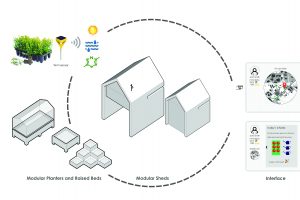Internet of Plants: Queen’s Clever Garden

INTERNET OF PLANTS: Queen’s Clever Garden, By Lina Tehari Spring 2017 StudioLab
Living in cities can be problematic for many people, some of these problems can be solved by embedding technology and connectivity into the very fabric of the city. By applying the concept of “Clever City” and utilizing the Internet of Things in both large and small scales, this project addresses the idea of community activities and their impact on improving quality of life for those engaging in these activities.
This project is a design proposal for a series of clever gardens which work as incubators/living labs for improving the quality of life for low income and homeless population of the City of Charlotte’s North End Smart District, by creating a new life routine, learning skills and getting access to healthy food in places that are recognized as food deserts. The gardens serve as a focal point for other communities to be engaged and join in. Most importantly, these gardens expose the problem of homelessness and the immediate needs of those experiencing it, while also providing easy access to healthy food in low income communities.
By integrating affordable and widely available technology into gardens, the production efficiency of these community gardens can be ensured and potentially increased. Each smart garden has different components; 1) Physical components, 2) Interface and 3) Data collection from both the plant sensors and the interface.
The specification of locations for the garden system is driven by layers of city data. The City of Charlotte has one of the largest open networks of information about city services and demographic information in the U.S. Location of the vacant lots within walking distance of Charlotte Homeless shelters and services were used to initially identify ideal places to locate the gardens.
The physical components of the gardens include modular planters and raised beds and modular sheds, as well as individual sensors that collect soil moisture and temperature, Nitrogen content, and amount of light.
The sheds are the hub for gardeners to interact with the interface, they accommodate tools, and touch screens for the interface, and they work as classrooms for learning skills and connecting to professionals and gardening databases. Each shed is equipped with a weather station and wi-fi. The shed’s building is the simplest modular form that could easily be repeated and moved around. Each garden could have multiple sheds that would accommodate different equipment such as a server room, and refrigerator and packing equipment for the harvest.





